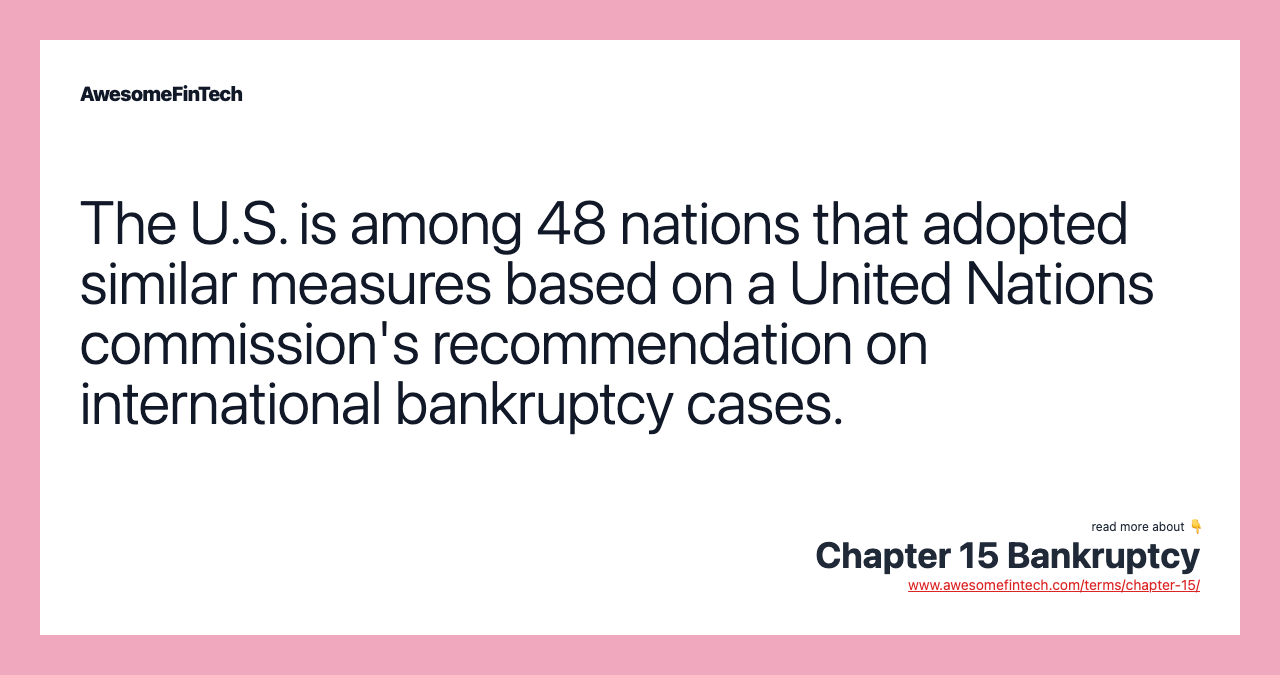Chapter 15 Bankruptcy
Chapter 15 is a section in the U.S. Bankruptcy Code that was added in 2005 to provide for cooperation between U.S. courts and foreign courts when foreign bankruptcy proceedings touch upon U.S. financial interests. The purpose of Chapter 15 is outlined in the following objectives listed in Title 11, Chapter 15, Section 1501 of the U.S. Code: Promoting cooperation among U.S. courts and parties of interest and the courts of other countries involved in cross-border insolvencies Establishing a better legal foundation for cross-border investment and trade Providing for better administration of cross-border insolvencies that protects the interests of all parties Protecting the value of the debtor’s assets Assisting financially troubled companies The number of countries that have adopted their own form of Chapter 15, based on the United Nations Commission on International Trade Law’s “Model Law on International Commercial Arbitration.” Chapter 15 was added to federal law as part of the Bankruptcy Abuse Prevention and Consumer Protection Act of 2005. Chapter 15 is a section in the U.S. Bankruptcy Code that was added in 2005 to provide for cooperation between U.S. courts and foreign courts when foreign bankruptcy proceedings touch upon U.S. financial interests. Chapter 15 bankruptcy fosters cooperation among U.S. courts, appointed representatives, and foreign courts in bankruptcy cases filed outside the U.S. The primary goal of Chapter 15 bankruptcy is to promote cooperation among U.S. courts, their appointed representatives, and foreign courts and to make legal proceedings of international bankruptcies more predictable and fair for debtors and creditors.

What Is Chapter 15?
Chapter 15 is a section in the U.S. Bankruptcy Code that was added in 2005 to provide for cooperation between U.S. courts and foreign courts when foreign bankruptcy proceedings touch upon U.S. financial interests.
The section was added in response to a United Nations recommendation for cooperation among nations on what it calls "cross-border insolvency."



Understanding Chapter 15
The primary goal of Chapter 15 bankruptcy is to promote cooperation among U.S. courts, their appointed representatives, and foreign courts and to make legal proceedings of international bankruptcies more predictable and fair for debtors and creditors.
As such, Chapter 15 focuses on jurisdiction. It also tries to protect the value of the debtor’s assets and, when possible, financially rescue an insolvent business.
Chapter 15 allows a representative in a corporate bankruptcy case that has been filed outside the United States (also known as a “cross-border insolvency”) to obtain access to the U.S. court system. This is intended to provide an efficient and common-sense mechanism for addressing insolvencies that involve debtors, creditors, and assets associated with more than one country. The purpose of Chapter 15 is outlined in the following objectives listed in Title 11, Chapter 15, Section 1501 of the U.S. Code:
The number of countries that have adopted their own form of Chapter 15, based on the United Nations Commission on International Trade Law’s “Model Law on International Commercial Arbitration.”
Chapter 15 History
Chapter 15 was added to federal law as part of the Bankruptcy Abuse Prevention and Consumer Protection Act of 2005. It was based on the United Nations Commission on International Trade Law’s “Model Law on Cross-Border Insolvency.”
A total of 48 countries, including Japan, Canada, China, Australia, the United Kingdom, Russia, Germany, Saudi Arabia, and Mexico, have adopted this law to reduce the risk for creditors and stakeholders of international companies.
Formally referred to as “Chapter 15, Title 11 of the United States Code,” Chapter 15 has its origins in Section 304 of the U.S. Bankruptcy Code, which was enacted in 1978. Given the increasing frequency of bankruptcies involving more than one jurisdiction, Section 304 was repealed in 2005 and replaced with Chapter 15, which carries the title of “Ancillary and Other Cross Border Cases.”
The Old Chapter 15
From 1978 to 1986, Chapter 15 had a different purpose as it relates to the Bankruptcy Code. During that time Chapter 15 related to the United States Trustee Program, a U.S. Department of Justice program that oversees the administration of bankruptcy cases and the private trustees that participate in them.
Chapter 15 in this context worked as a trial in certain judicial districts to afford the trustees' powers once reserved to bankruptcy judges. The changes were adopted and folded into the Bankruptcy Code.
Related terms:
341 Meeting
“341 meeting” refers to a meeting between creditors and debtors that is required to take place during the course of a Chapter 7 bankruptcy proceeding. read more
Absolute Priority
Absolute priority is a rule that stipulates the order of payment in the event of liquidation among creditors and shareholders. read more
Bankruptcy Court
Bankruptcy court is a specific kind of federal court that deals with bankruptcy. read more
Bankruptcy Trustee
A bankruptcy trustee is a person appointed by the United States Trustee to represent the debtor's estate during a bankruptcy proceeding. read more
Bankruptcy
Bankruptcy is a legal proceeding for people or businesses that are unable to repay their outstanding debts. read more
Bankruptcy Financing
Bankruptcy financing is financing arranged by a company while under the chapter 11 bankruptcy process. read more
Bankruptcy Risk
Bankruptcy risk refers to the likelihood that a company will be unable to meet its debt obligations. read more
Bankruptcy Abuse Prevention and Consumer Protection Act (BAPCPA)
BAPCPA was passed by Congress and signed into law by President George W. Bush as a move to reform the bankruptcy system. read more
Chapter 15 Bankruptcy
Chapter 15 of the U.S. Bankruptcy Code allows for cooperation between U.S. and foreign courts in bankruptcy cases that touch upon U.S. interests. read more
Chapter 10 Bankruptcy
Chapter 10 was a type of corporate bankruptcy filing that was retired in 1978 due to its complexity and then partially incorporated into Chapter 11. read more